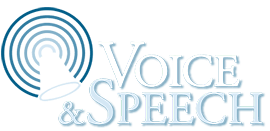Transcript
You’ll often hear people complain about having a nasal voice or that their voice sounds nasally. In some cases that’s true, but sometimes that’s not the real problem. Let me begin by saying nasality is not all bad. Nasal resonance is an important part of your voice. If you had no nasal resonance you’d have what we call hypo-nasality. That’s how you sound when you have a head cold and your nose is blocked. It’s not desirable.
Having too much nasal resonance is called hyper-nasality, and that’s the sound you typically recognize as being nasally. So the truth is, you need a certain amount of nasal resonance. You just don’t want too much or too little.
Balancing nasal resonance in your speaking voice requires you to get acquainted with your soft palate. The soft palate is a muscle on the roof of your mouth, in the back. It governs the opening between your pharynx (your throat) and your nasal passages.
When you swallow, your soft palate raises and closes the passage, so food and drink go down your throat and not up into your nose. Don’t try laughing while you swallow something or you’ll discover this the hard way.
When you yawn, your soft palate tends to raise, creating a larger dome-shaped space in the back of your throat. That increases resonance, so people who make noise when they yawn produce this bigger, rounder sound.
When you speak, in English, your soft palate is generally raised—that’s overly simplified, but—generally raised. so breath and sound exit through your mouth. When your soft palate is lazy and hanging down, breath and sound escape through your nasal passages producing hyper-nasality.
In my experience, soft palate practice is one of the trickier aspects of voice training. It’s not something I do with a beginner, and certainly not something you can learn from a 5-minute video, but here are some basic suggestions. You’ll need a mirror.
Make sure you’re opening your mouth far enough when you speak, at least a finger-width of space on average. If your jaw is tense and your mouth doesn’t open enough, sound is forced to find another way out and that’s through your nose.
Yawn as you inhale and see how far your soft palate can raise. Then yawn as you inhale and allow sound to come out as you exhale without lowering your soft palate. It doesn’t have to sound good or sound natural or normal; you’re just trying to learn the feeling of lifting your soft palate and releasing sound with more space back there.
Now count from one to five, or say the days of the week, picturing your soft palate being raised and cultivating the feeling of a big dome in the back of your mouth. Don’t force this; just imagine it. Allow the right thing to happen rather than making it happen.
There are other, more advanced exercises for training your soft palate, but they’re a bit complicated to explain on a short video, so start with these simple things, practice daily for a month or two and see what happens.
When your soft palate muscle becomes more toned and responsive, the brightness and focus of nasal resonance will be balanced by the warmth and richness of pharyngeal and torso resonance. Instead of that high, brassy nasally voice, you’ll speak with a voice that’s strong, credible and engaging for your listeners.
For more exercises to help you start balancing the resonance of your voice, click the link in the description box and enroll in the free video mini course, The Sound of Success.
Voice Training: Nasal Resonance
It’s common to hear people complain about their nasally voice. While some amount of nasal resonance is important to a well-balanced speaking voice, too much nasality, specifically hyper-nasality, produces a high, pinched tone of voice that can be unpleasant to hear. Adjusting the level of nasal resonance in your voice requires you to activate your soft palate. When your soft palate is lifting adequately your voice will be strong, energized and pleasing to the ear.


